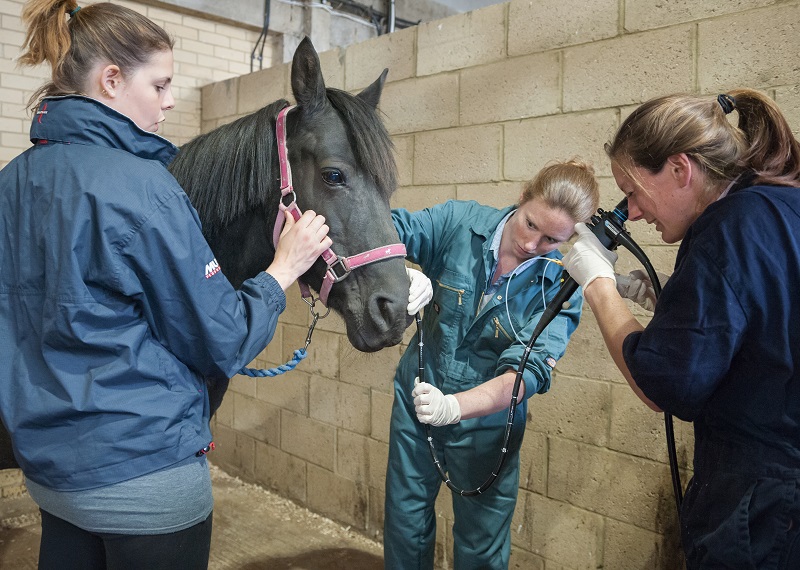24 hour contact: 01707 666297
Respiratory diseases
Respiratory diseases in horses are very common and have a variety of different causes. Infectious respiratory diseases caused by bacterial and viral infections, for example strangles and influenza, occur in horses of all ages and are particularly common in young horses, especially those kept in larger groups or yards.
Non-infectious respiratory diseases are also common and are frequently due to hypersensitivities to allergens in the stable environment, for example inflammatory airway disease in younger horses and equine asthma, previously known as recurrent airway obstruction (RAO), chronic obstructive pulmonary disorder (COPD) or ‘heaves’, in older horses.

Clinical signs
Equine respiratory diseases tend to cause similar clinical signs in the early stages which means that differentiation of specific problems can be initially difficult on clinical examination alone and laboratory tests are frequently required to reach a diagnosis. Differentiation on clinical grounds can even be difficult in the later stages of disease. Common clinical signs that occur with respiratory diseases are:
- Coughing
- Nasal discharge
- Reluctance to work
Coughing is a specific sign of respiratory disease, but is not very sensitive. In other words, if a horse is coughing it has respiratory disease but a significant proportion of horses with respiratory disease do not cough, or cough only occasionally.
Horses with infectious causes of respiratory disease may also show:
- Fever (rectal temperature greater than 38.5C)
- Being off colour or depressed
- Loss of appetite or unwillingness to eat
- Increase in size of lymph nodes (‘lymph glands’) around the head, especially between the mandibles and at the throat latch
Fever may only be present intermittently and so it is important to monitor temperatures twice daily during an outbreak to pick up all horses that have been infected. Although each of the common infectious respiratory diseases seen in horses in the UK (strangles, equine influenza and equine herpesviruses) can cause obvious clinical disease with distinguishing clinical signs (for example, abscesses in strangles and persistent, harsh, dry coughing in influenza) in most outbreaks, especially in adult horses, a lot of infected horses show only mild signs of disease and may only develop an isolated spike of fever. Detection of infectious diseases therefore requires vigilance and routine health monitoring of all horses in a yard is therefore an essential part of biosecurity planning.
Horses with non-infectious respiratory disease, for example recurrent airway obstruction, often show the following clinical signs in addition to coughing, nasal discharge and reluctance to work:
- Increased breathing rate at exercise
- Inappropriately long recovery times after exercise
- Increased breathing rate at rest
- Increased breathing effort at rest
Less commonly, horses develop infectious disease of the lower respiratory tract (bronchial tree and lungs) such as bronchopneumonia or pleuropneumonia. The clinical signs with these diseases vary from acute life-threatening disease to more chronic (long-term) disease with signs that include weight loss, signs of colic and bloody nasal discharge.
Causes
The common infectious equine respiratory diseases are strangles, equine influenza and the equine herpesviruses. Other infections also circulate including the equine rhinitis viruses and equine adenoviruses, but these are less common. Reliable differentiation of these disease requires laboratory testing and it is usually not possible to make a definitive diagnosis on the basis of clinical signs alone.
Strangles is caused by the bacterium Streptococcus equi and is probably the most common infectious respiratory disease affected horses in the UK. The bug is transmitted mainly by infected respiratory droplets from horse to horse and in yards is passed very effectively from horses to horse by people’s hands, feed utensils and other husbandry equipment. Classical strangles disease causes depression, copious pus-like nasal discharge, difficulty swallowing, some coughing, development of abscesses in lymph nodes around the head and possibly other more serious problems such as obstruction of the airway and disseminated abscesses around the body (known as ‘bastard strangles’). Some horses develop persistent infections of their guttural pouches, with our without obvious pouch disease, and become carriers of the disease acting as Trojan horses transmitting disease silently to others.
Equine influenza is caused by equine influenza virus, a virus distinct from those influenza viruses that cause flu in humans and other species. The disease can cause huge outbreaks and, as a result, is of great concern to the horse industry with extensive surveillance undertaken to monitor disease spread and the appearance of new influenza viruses. It is for this reason that there is mandatory vaccination of horses that travel for competition, showing and breeding and since its introduction in the early 1980’s, mandatory vaccination has had a significant impact on reducing equine influenza disease.
Because flu viruses gradually change of time, the strains of virus that are included in vaccines are periodically updated to ensure efficacy. Flu outbreaks generally only occur in unvaccinated horses or in horses whose vaccination programmes are incomplete or have lapsed. In young or completely naïve horses, flu causes sudden onset disease with fever, depression, nasal discharge, lymph node enlargement and frequent, dry, paroxysmal coughing. In older horses, or horses with partial immunity, the disease can much less distinct and mild. Horses usually make a good recovery, although post viral ME-like syndromes are reported and in new-born foals the disease can be fatal.
The equine herpesviruses are most feared because of their ability to cause abortion and neurological disease (weakness and/or paralysis). They also cause respiratory disease which is generally mild and is usual route by which the virus enters the horse’s body.
The most common equine non-infectious respiratory diseases are inflammatory airway disease and recurrent airway obstruction. Both cause chronic (long-term) disease presenting with coughing and reluctance to exercise or reduced ability, usually with nasal discharge, but in horses which are otherwise bright and well. Inflammatory airway disease occurs mainly in younger horses up to approximately six years old whereas recurrent airway obstruction occurs mainly in older horses and also causes changes to lung function which manifests as changes to respiratory rate and effort. Both diseases are allergic diseases with the horse’s lower respiratory tract reacting to allergens in stable air, especially moulds, fungi and other allergenic organic materials. Inflammatory airway disease might occasionally have complicating bacterial infections but this is rare in recurrent airway obstruction. Inhalation of the allergen triggers inflammation of the airways, which become irritated and constrict. There is then an accumulation of inflammatory cells and increased mucus production.
The majority of younger horses that develop inflammatory airway disease appear to make a recovery but recurrent airway obstruction tends to be a persistent disease which means that permanent changes to the environment are required to manage the condition. For example, by permanently turning out the horse, ensuring stables are clean and well-ventilated and using wood chips or paper for bedding.
Diagnosis
Because many equine respiratory diseases can look alike in clinical examination, your vet will usually need to carry out diagnostic tests to establish the precise cause. For the infectious diseases, this will involve collecting samples from the respiratory tract (nasal or nasopharyngeal swabs, or washes from the guttural pouch) and submitting these to a laboratory for testing for bacteria and viruses.
Endoscopy (a long flexible camera) is also a very useful technique that allows your vet to examine the respiratory tract and collect samples from further down the tract including the trachea and lungs. These samples can also be tested for bacteria and viruses and well as characterising the cells present. Radiography (X-rays) can provide useful information about lung diseases such as bronchopneumonia. Ultrasonography is very useful for identified localised lung problems such as abscesses and also diseases where there is fluid in the chest cavity, such as pleuropneumonia.
Key points
- Respiratory diseases are common and important in the horse
- Many respiratory diseases can look alike, especially in the early stages, and so veterinary involvement and laboratory testing are essential to identify which problems you are dealing with
- The common infectious respiratory diseases are strangles, equine influenza and herpesviruses
- Mandatory vaccination for influenza has provided good control of this disease and vaccines are also available for strangles and herpesvirus infections
- The common non-infectious respiratory diseases are inflammatory airway disease and recurrent airway obstruction which are allergic diseases requiring careful management of air hygiene and the stable environment
- Monitoring horses for signs of respiratory disease, combined with prompt investigation and treatment, is an essential part of equine health and biosecurity planning

